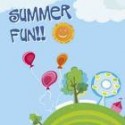Messy Summer Science Experiments!
by kyla palin

Ok so school’s out, you’ve watched every episode of your favourite show on Netflix and you’re trying to avoid doing chores. Or maybe you’re trying to entertain the kids you’re babysitting, a younger sibling or two, or just really, really feel like making a mess! Here are a few experiments that are fun, messy, and educational! No one can get angry about a mess when you’re learning. Right?
*TIP: Do these outside.*
- Giant bubbles: Everyone loves making bubbles, but giant ones are even better! This takes simple supplies you may already have around the house. You’ll need string, plastic straws, bubble solution, and a flat container like a cookie sheet. You’ll attach the string through the straws to form a big circle with “handles” (the straws). Then you can create large bubbles to delight kids of all ages. PBS.org has a great how to, with photos at their website: http://www.pbs.org/parents/crafts-for-kids/really-big-bubble-maker/
- Rainbow Bubble Snakes: Do you have a pile or a drawer full of socks missing a match? This activity will use those poor lonely socks. You will need a water bottle, an orphaned sock, food colouring and dish soap. This website (http://www.housingaforest.com/rainbow-bubble-snakes/) has the detailed instructions with photos that show just how fun and messy things will get. See how long of a bubble snake you can create. Can you create a rainbow? How many different colour combinations can you create?
- Outrageous Ooze: One of my favourite messy experiments involves corn starch. You only need corn starch and water. You can add food colouring if you want more mess (who doesn’t?). The corn starch feels so silky smooth and the properties it exhibits while you play in it are so soothing. When you manage to get the consistency right, it will look like a liquid in the container, but if you smack the surface of it hard with the palm of your hand, it feels solid! I did this one with 5 year olds, and while they didn’t “get” the science behind it, they had a blast! You older kids will enjoy it as well, as you explore non-Newtonian fluids. This site shows you how to do it, and explains the chemistry behind the ooze. https://www.exploratorium.edu/science_explorer/ooze.html
- Ice cream in baggies: Now for an experiment you can eat! Did you know you can make ice cream in a baggie with your own two hands? This website lists the recipe and the detailed instructions. (http://teachnet.com/lessonplans/science/plastic-bag-ice-cream-recipe/ ) but suffice it to say that this experiment is a delicious way to explore chemistry. I highly suggest this activity be done outside in case a baggie leaks, and bring your spoons. As an alternative, try doing more than a single serving in a coffee can, rolling it back and forth between you and a friend until the ice cream sets. Don’t forget your winter gloves, your hands will get very cold! Have fun!





Leave a comment!